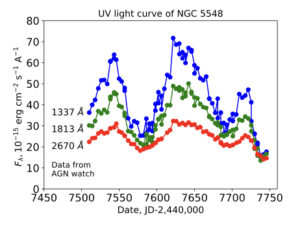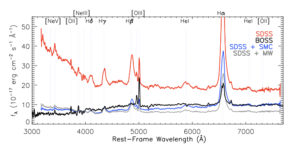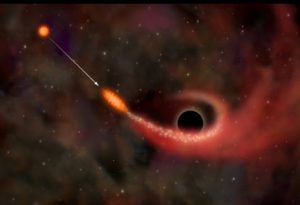Galaxies are made of stars, gas, and dust, embedded in a mysterious dark matter halo. However in the centres of some galaxies -their nuclei – we see a bright spot showing that something stranger is going on. In these “Active Galactic Nuclei” or “AGN”, we see a huge luminous output from a very small region; radiation output unlike stars, with strong ultraviolet, X-ray, and radio emission; glowing gas moving at many thousands of km/sec; and, sometimes, twin jets of radio plasma shooting out of the nucleus at speeds close to the peed of light. Some of the more distant AGN can be so powerful they outshine their parent galaxies, and all we see is a spot of light. These are the quasars.

For many decades we have had a rough theory of what is going on. A disc of gas – a so called accretion disc – is gradually swirling in towards a central supermassive black hole. Black holes are black, but the stuff surrounding them is not! It heats up as it descends, shining very brightly. This theory works well to first order, but has proved very hard to get right in detail – which has kept us all busy of course. Over many years I have worked on the energy distributions of AGN, on how obscuration produces different types, on the relation between AGN and starburst galaxies, and on discovery of high redshift quasars, but most recently my worked has been centred on the variability of AGN.

All AGN flicker in brightness from month to month, especially in X-rays and ultraviolet. This is a problem for the standard accretion disc theory, because the disc ought to change over thousands of years, not months. This problem got worse over the last few years, as we realised that some AGN (and probably all AGN sometimes…) vary not just by tens of percent, but by factors of several, over a few years. Some of these events are probably illusory outbursts caused by gravitational focusing by a star in an intervening galaxy, but most events are real. Some of the outbursts in nearby galaxies are we think Tidal Disruption Events (TDEs)… a quiescent black hole leaps back into life when an unfortunate star passes too close and gets shredded. These are fascinating events in their own right.. But its hard to avoid the conclusion that accretion discs around black holes are much more erratic and interesting than we had thought.

Over the next few years, there will hopefully be some advances in theoretical studies – especially involving supercomputer simulations of this complex process. But it will also be a golden age for developing new observational clues, as LSST will produce light curves of millions of quasars, and a variety of new facilities will monitor thousands of AGN and quasars spectroscopically. We really are in need of some clues!

If you are interested in a more technical look at some of these topics, follow the trail through my science papers, and on my research talks page.
